
Rococo architecture entered Portugal through the north, while Lisbon, due to the court pomp, remained in the Baroque.

Rococo architecture entered Portugal through the north, while Lisbon, due to the court pomp, remained in the Baroque.
It is an architecture that follows the international taste in decoration, and, as a result of the contrast between dark granite and white walls, has a clearly Portuguese profile. The decoration is naturalist, based mainly in shells and leaves but also with architectural elements and sculpture. Pilgrimage places became fashionable, often built in places of rough prominence, allowing impressive staircases of big scenographic effect. André Soares worked in the region of Braga, and produced some of the main examples such as Falperra Church, Congregados Basilica, the Braga City Hall, and Raio Palace, among many others. The number of buildings and architects is large and, because the north of Portugal was spared from the ravages of the 1755 Lisbon earthquake, there is a large number of buildings.
In the south, as a result of the lower population density, the court taste and also of the consequence of the earthquake there are fewer rococo buildings. But there still remain many examples such as the Palace of Queluz. Designed by Mateus Vicente de Oliveira, it became the residence of the royal family under the reign of Queen Maria I. Made according to the French taste for prince Dom Pedro, King José’s brother, it is characterized by good taste and elegance. It boasts Rococo gardens and water games in a large park. The interior is decorated with paintings, sculptures, mirrors, tile, and gilded woodcarving. The chapel, as a result of the junction of carved wood, marble and coloured stones, reflects a classical taste unusual in the Portuguese Rococo. The building received subsequent extensions during the neoclassical period.
Lisbon’s main Rococo church, the Estrela Basilica, is the last major Rococo building in the city, showing the influence of Palace of Mafra, but has also undeniable similarities with Pombaline style churches, particularly in the front. The elegant towers and dome cannot hide the Pombaline style vocabulary at the façade, despite the sculpture and relieves. The interior is covered with traditional Baroque coloured marbles.
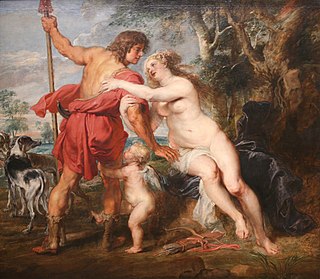
The Baroque is a Western style of architecture, music, dance, painting, sculpture, poetry, and other arts that flourished from the early 17th century until the 1750s. It followed Renaissance art and Mannerism and preceded the Rococo and Neoclassical styles. It was encouraged by the Catholic Church as a means to counter the simplicity and austerity of Protestant architecture, art, and music, though Lutheran Baroque art developed in parts of Europe as well.

Rococo, less commonly Roccoco, also known as Late Baroque, is an exceptionally ornamental and dramatic style of architecture, art and decoration which combines asymmetry, scrolling curves, gilding, white and pastel colours, sculpted moulding, and trompe-l'œil frescoes to create surprise and the illusion of motion and drama. It is often described as the final expression of the Baroque movement.

Cathedrals, collegiate churches, and monastic churches like those of abbeys and priories, often have certain complex structural forms that are found less often in parish churches. They also tend to display a higher level of contemporary architectural style and the work of accomplished craftsmen, and occupy a status both ecclesiastical and social that an ordinary parish church rarely has. Such churches are generally among the finest buildings locally and a source of regional pride. Many are among the world's most renowned works of architecture. These include St Peter's Basilica, Notre-Dame de Paris, Cologne Cathedral, Salisbury Cathedral, Antwerp Cathedral, Prague Cathedral, Lincoln Cathedral, the Basilica of Saint-Denis, Santa Maria Maggiore, the Basilica of San Vitale, St Mark's Basilica, Westminster Abbey, Saint Basil's Cathedral, Antoni Gaudí's incomplete Sagrada Família and the ancient cathedral of Hagia Sophia in Istanbul, now a mosque.

Baroque architecture is a highly decorative and theatrical style which appeared in Italy in the early 17th century and gradually spread across Europe. It was originally introduced by the Catholic Church, particularly by the Jesuits, as a means to combat the Reformation and the Protestant church with a new architecture that inspired surprise and awe. It reached its peak in the High Baroque (1625–1675), when it was used in churches and palaces in Italy, Spain, Portugal, France, Bavaria and Austria. In the Late Baroque period (1675–1750), it reached as far as Russia, the Ottoman Empire and the Spanish and Portuguese colonies in Latin America. In about 1730, an even more elaborately decorative variant called Rococo appeared and flourished in Central Europe.

Sicilian Baroque is the distinctive form of Baroque architecture which evolved on the island of Sicily, off the southern coast of Italy, in the 17th and 18th centuries, when it was part of the Spanish Empire. The style is recognisable not only by its typical Baroque curves and flourishes, but also by distinctive grinning masks and putti and a particular flamboyance that has given Sicily a unique architectural identity.

Azulejo is a form of Portuguese and Spanish painted tin-glazed ceramic tilework. Azulejos are found on the interior and exterior of churches, palaces, ordinary houses, schools, and nowadays, restaurants, bars and even railways or subway stations. They are an ornamental art form, but also had a specific functional capacity like temperature control in homes.

Spanish Baroque is a strand of Baroque architecture that evolved in Spain, its provinces, and former colonies.

The Palace of Mafra, also known as the Palace-Convent of Mafra and the Royal Building of Mafra, is a monumental Baroque and Neoclassical palace-monastery located in Mafra, Portugal, some 28 kilometres from Lisbon. Construction began in 1717 under King John V of Portugal and was completely concluded in 1755.
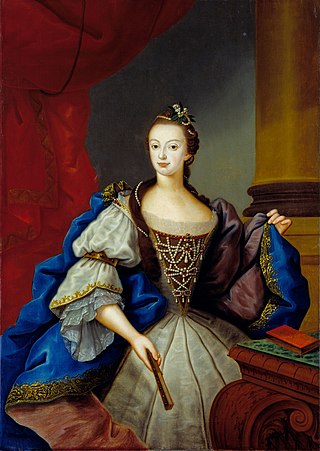
The Palace of Queluz is an 18th-century palace located at Queluz, a city of the Sintra Municipality, in the Lisbon District, on the Portuguese Riviera. One of the last great Rococo buildings to be designed in Europe, the palace was conceived as a summer retreat for King José I's brother, Pedro of Braganza, later to become husband and king jure uxoris to his own niece, Queen Maria I. It eventually served as a discreet place of incarceration for Maria I, when she became afflicted by severe mental illness in the years following Pedro III's death in 1786. Following the destruction of Ajuda Palace by fire in 1794, Queluz Palace became the official residence of the Portuguese Prince Regent João, and his family, and remained so until the royal family fled to the Portuguese colony of Brazil in 1807, following the French invasion of Portugal.

Ribeira Palace was the main residence of the Kings of Portugal, in Lisbon, for around 250 years. Its construction was ordered by King Manuel I of Portugal when he found the Royal Alcáçova of São Jorge unsuitable. The palace complex underwent numerous reconstructions and reconfigurations from the original Manueline design, ending with its final Mannerist and Baroque form.
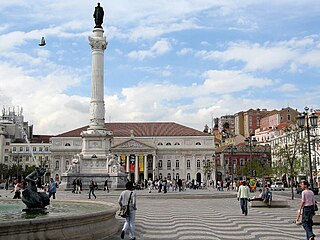
The Rossio is the popular name of the King Pedro IV Square in the city of Lisbon, in Portugal. It is located in the Pombaline Downtown of Lisbon and has been one of its main squares since the Middle Ages. It has been the setting of popular revolts and celebrations, bullfights and executions, and is now a preferred meeting place of Lisbon natives and tourists alike.

Portuguese architecture refers to both the architecture of Portugal's modern-day territory in Continental Portugal, the Azores and Madeira, as well as the architectural heritage/patrimony of Portuguese architects and styles throughout the world, particularly in countries formerly part of the Portuguese Empire.

The Pombaline style was a Portuguese architectural style of the 18th century, named after Sebastião José de Carvalho e Melo, the first Marquês de Pombal, who was instrumental in reconstructing Lisbon after the earthquake of 1755. Pombal supervised the plans drawn up by the military engineers Manuel da Maia, Eugénio dos Santos and Elias Sebastião Pope. The new city was laid out on a grid plan with roads and pavements fixed at 40 ft wide (12 m). The previously standing Royal Palace was replaced with the Praça do Comércio which, along with square Rossio, defines the limits of the new city.

The Palace of Raio is a Baroque era residence in the urbanized area of the municipality of Braga, in the civil parish of São José de São Lázaro. It is an example of the late Baroque, early Rococo style of decoration by Portuguese architect André Soares, notable for his influence in the northern Baroque movement.
The architecture of the Portuguese Renaissance intimately linked to Gothic architecture and gradual in its classical elements. The Manueline style was a transitional style that combined Renaissance and Gothic ornamental elements to buildings that were architectonically closer to Gothic architecture, as is the Isabelline style of Spain. Manueline was succeeded by a brief Early Renaissance phase, closer to Classical canons, followed by the adoption of Mannerist forms. Portuguese Mannerism, specially in secular architecture, is characterised by simplicity in the organisation of façades and relative lack of decoration, being often referred to as Estilo Chão. Even with the arrival of Baroque architecture in the late 17th century, Portuguese architecture continued to use Mannerist forms well into the 18th century.

Baroque architecture in Portugal lasted about two centuries. The reigns of John V and Joseph I had increased imports of gold and diamonds, in a period called Royal Absolutism or Absolute monarchy, which allowed the Portuguese Baroque to flourish.

Gilded woodcarving in Portugal is, along with azulejos, one of the country's most original and rich artistic expressions. It is usually used in the interior decoration of churches and cathedrals and of noble halls in palaces and large public buildings. An impressive collection of altarpieces are found in Portuguese churches. Originating in the Gothic era, Portuguese gilded woodcarving assumed a nationalist character during the 17th century and reached its height in the reign of King D. João V. In the 19th century it lost its originality and began to disappear with the end of the revival era.
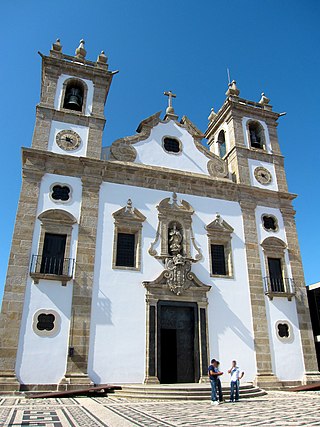
The architecture of Póvoa de Varzim, in Portugal, demonstrates a broad variety of architectural styles over its thousand years of history. 11th-century Romanesque, 16th-century Mannerism, 18th-century Baroque, late 18th-century neoclassicism, early 20th-century Portuguese modernism and late 20th- to early 21st-century contemporary architectural styles and more are all represented in Póvoa de Varzim. As a whole it represents a rich eclectic tradition and innovation shaped by the people, their beliefs and economy.
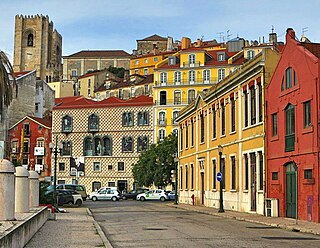
Lisbon is one of the most popular city destinations in Europe. The city of Lisbon and the Lisbon metropolitan area attracts a significant number of tourists each year, drawn to its historical and cultural heritage, good transportation connections and good touristic infrastructure.

The colonial architecture of Brazil is defined as the architecture carried out in the current Brazilian territory from 1500, the year of the Portuguese arrival, until its Independence, in 1822.